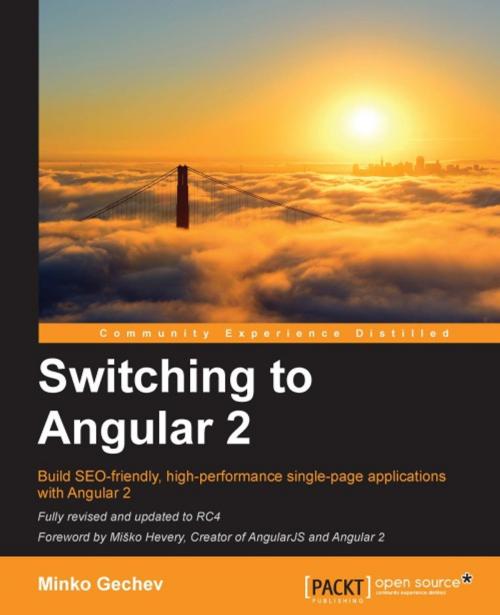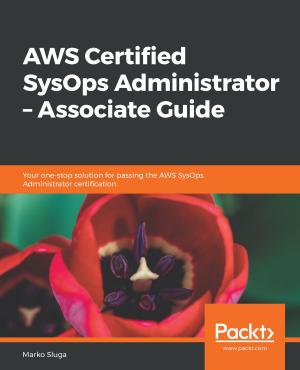Switching to Angular 2
Nonfiction, Computers, Programming, Programming Languages, CGI, JavaScript, Perl, VBScript, Internet, Web Development| Author: | Minko Gechev | ISBN: | 9781785887116 |
| Publisher: | Packt Publishing | Publication: | March 30, 2016 |
| Imprint: | Packt Publishing | Language: | English |
| Author: | Minko Gechev |
| ISBN: | 9781785887116 |
| Publisher: | Packt Publishing |
| Publication: | March 30, 2016 |
| Imprint: | Packt Publishing |
| Language: | English |
Build SEO-friendly, high-performance single-page applications with Angular 2
About This Book
- Get up to date with the latest changes to Angular 2, including the improvements to directives, change detection, dependency injection, router, and more
- Understand Angular 2's new component-based architecture
- Start using TypeScript to supercharge your Angular 2 applications
Who This Book Is For
Do you want to jump in at the deep end of Angular 2? Or perhaps you're interested assessing the changes before moving over? If so, then Switching to Angular 2 is the book for you.
To get the most out of the book, you'll need to be familiar with AngularJS 1.x, and have a good understanding of JavaScript. No knowledge of the changes made to Angular 2 is required follow along.
What You Will Learn
- Understand the changes made from Angular 1.x with side-by-side code samples to help demystify the Angular 2 learning curve
- Start working with Angular 2's new method of implementing directives
- Use TypeScript to write modern, powerful Angular 2 applications
- Dig in to the change-detection method, and other architectural changes to make sure you know what's going on under the hood of Angular 2.
- Get to work with the new router in Angular 2
- Use the new features of Angular 2 including pipes, or the updated features such as forms, services, and the DI module
- Master server-side rendering in Angular 2 to keep your new applications SEO friendly
In Detail
AngularJS is a JavaScript framework that makes building web applications easier. It is used today in large-scale, high-traffic websites that struggle with under-performance, portability issues, as well as SEO unfriendliness, and complexity at scale.
Angular 2 changes that.
It is the modern framework you need to build performant and robust web applications. “Switching to Angular 2” is the quickest way to get to grips with Angular 2 and will help you transition in to the brave new world of Angular 2.
We'll start with an overview which sets the changes of the framework in context with version 1.x. After that, you will be taken on a TypeScript crash-course so we can take advantage of Angular 2 in its native, statically-typed environment. We'll look at the new change-detection method in detail, how Directives and Components change how you create websites with Angular, the new Angular 2 router, and much more.
By the end of the book, you'll be ready to start building quick and efficient Angular 2 applications that take advantage of all the new features on offer.
Style and approach
Starting with a comparison between Angular versions that is filled with side-by-side code examples to help highlight the changes, each chapter then looks at major changes to the framework as is filled with small examples and sample code to get you started
Build SEO-friendly, high-performance single-page applications with Angular 2
About This Book
- Get up to date with the latest changes to Angular 2, including the improvements to directives, change detection, dependency injection, router, and more
- Understand Angular 2's new component-based architecture
- Start using TypeScript to supercharge your Angular 2 applications
Who This Book Is For
Do you want to jump in at the deep end of Angular 2? Or perhaps you're interested assessing the changes before moving over? If so, then Switching to Angular 2 is the book for you.
To get the most out of the book, you'll need to be familiar with AngularJS 1.x, and have a good understanding of JavaScript. No knowledge of the changes made to Angular 2 is required follow along.
What You Will Learn
- Understand the changes made from Angular 1.x with side-by-side code samples to help demystify the Angular 2 learning curve
- Start working with Angular 2's new method of implementing directives
- Use TypeScript to write modern, powerful Angular 2 applications
- Dig in to the change-detection method, and other architectural changes to make sure you know what's going on under the hood of Angular 2.
- Get to work with the new router in Angular 2
- Use the new features of Angular 2 including pipes, or the updated features such as forms, services, and the DI module
- Master server-side rendering in Angular 2 to keep your new applications SEO friendly
In Detail
AngularJS is a JavaScript framework that makes building web applications easier. It is used today in large-scale, high-traffic websites that struggle with under-performance, portability issues, as well as SEO unfriendliness, and complexity at scale.
Angular 2 changes that.
It is the modern framework you need to build performant and robust web applications. “Switching to Angular 2” is the quickest way to get to grips with Angular 2 and will help you transition in to the brave new world of Angular 2.
We'll start with an overview which sets the changes of the framework in context with version 1.x. After that, you will be taken on a TypeScript crash-course so we can take advantage of Angular 2 in its native, statically-typed environment. We'll look at the new change-detection method in detail, how Directives and Components change how you create websites with Angular, the new Angular 2 router, and much more.
By the end of the book, you'll be ready to start building quick and efficient Angular 2 applications that take advantage of all the new features on offer.
Style and approach
Starting with a comparison between Angular versions that is filled with side-by-side code examples to help highlight the changes, each chapter then looks at major changes to the framework as is filled with small examples and sample code to get you started















